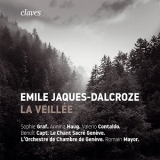 Emile Jaques-Dalcroze: La Veillée Suite lyrique pour chœur, soli et orchestre; Le Chant Sacré Genève, Orchestre de Chambre de Genève, Romain Mayor; 2 CDs Claves1905-06; Aufnahme 09/2018, Veröffentlichung 12/2019 (85') - Rezension von Remy Franck
Emile Jaques-Dalcroze: La Veillée Suite lyrique pour chœur, soli et orchestre; Le Chant Sacré Genève, Orchestre de Chambre de Genève, Romain Mayor; 2 CDs Claves1905-06; Aufnahme 09/2018, Veröffentlichung 12/2019 (85') - Rezension von Remy Franck
Emile Jaques-Dalcroze (1865-1950) ist vor allem als Pädagoge bekannt. Immerhin gibt es nach ihm benannte Institute in der Schweiz, in Belgien, Argentinien und einigen anderen Ländern. Der Schweizer wurde in Wien geboren und studierte Musik in Genf, Paris (bei Delibes und Fauré) und Wien (bei Bruckner).Er ist der Begründer einer rhythmischen, interaktiven und multidisziplinären Pädagogik, die auf der Musikalität von Bewegung und Improvisation basiert.Er komponierte Lieder, vier Opern, zwei Violinkonzerte, symphonische Werke und eine Fülle von Kammer- und Klaviermusik.
La Veillée entstand um die Jahrhundertwende und geht auf einen bäuerlichen Roman von George Sand zurück, Les Maîtres Sonneurs, der 1853 veröffentlicht wurde und die schwache Handlung in eine Vielzahl von einzelnen Veillées gießt. Jacques-Dalcroze schrieb dafür eine romantische, sehr beschauliche Musik mit Chören und Soli, die unbestreitbar viel Charme hat und auch ganz nett wirkt. Aber ohne dramatische Akzente zieht sie sich doch mit über 80 Minuten etwas lange hin. Immerhin aber gibt es einige tänzerische Stücke, die das Ganze etwas auflockern. Andererseits kann diese Folge ruhiger, sanfter und angenehm zu hörender Stücke durchaus einen entspannenden Charakter haben kann.
Die Darbietung ist stil- und stimmungsvoll, technisch auf bescheidenem, aber akzeptablem Niveau.
Emile Jaques-Dalcroze (1865-1950) is best known as a pedagogue. There are institutes named after him in Switzerland, Belgium, Argentina and some other countries.The Swiss musician was born in Vienna and studied music in Geneva, Paris (with Delibes and Fauré) and Vienna (with Bruckner). He is the founder of a rhythmic, interactive and multidisciplinary pedagogy based on the musicality of movement and improvisation. He has composed songs, four operas, two violin concertos, symphonic works and a lot of chamber and piano music.
La Veillée was written around the turn of the century and goes back to a peasant novel by George Sand, Les Maîtres Sonneurs, published in 1853, which pours the weak plot into a multitude of individual Veillées (vigils). Jacques-Dalcroze wrote a romantic, very contemplative music with choirs and solos, which undeniably has a lot of charm and is quite nice. But without any dramatic accents it is little long. At least there are some dances that loosen up the whole thing a bit. On the other hand, this series of quiet, gentle and pleasant pieces undoubtedly has a relaxing character. The performance is stylish and atmospheric, technically on a modest but acceptable level.
























